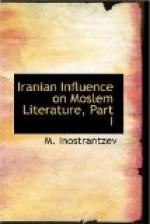Besides the two modes of writing which they owe to Zoroaster, the Persians have five other methods in many of which Nabatian words have been introduced. We have explained all these in our books already cited with quotations of portions regarding the miracles of Zoroaster, the marks and the proof of his revelation, the belief in the five eternal principles which are Ormazd or God, Ahriman which is the same as Satan, the wicked, Kah or time, Jay or space, Homa or the good spirituous liquor, the grounds on which they support these doctrines, the reasons why they render homage to the two luminaries and to other heavenly lights, the distinction which they make between fire and light, their discourses regarding the origin of the human species, on Mashya son of Gayomert, and Mashyana his daughter, and how the Persians trace their geneologies back to these two personages, and finally, other things connected with the exercise of their religion, the practice of their cult and the various places where they have established their fire sanctuaries.
[Sidenote: Confutation of prejudice Moslem theologians.]
Certain Musalman theologians and authors of books on various sects, and several authors who have set before them the task at different times of refuting Zoroastrianism have alleged that it is believed in their religion that from the reflexion of God on himself has issued an evil spirit or the devil and that God, indulgent towards him, has accorded him a certain time during which to tempt mankind. These authors further cite as appertaining to this religion propositions which the Magians themselves have always rejected. I believe that they must have heard these particulars from ordinary people and that they have recorded them as the authentic expression of the followers of the religion of Zoroaster.[1]
[Footnote 1: Our celebrated Arab polyhistor not only does not malign the faith of Zoroaster but proceeds to confute his prejudiced co-religionists who pretended to refute the old faith of Iran.]
SHAHARASTANI.
KITAB AL MILAL VAL NIHAL.
(Page 112, Bombay Edition. Compare also page 83 of the Egyptian Edition on the margin of Ibn Hazm.)
THE MAGIANS.
These people believe in two Principles as we have already stated; only, that the original Magians were of the belief that it was not possible that there should be two Principles eternal and without beginning, but that the light was without beginning and darkness was only produced; and they were of different views as regards the origin of its rise,—whether it arose from light, since light cannot bring something that was partly evil. How then could the principle of evil or anything else arise since there was nothing at first which participated with light in its production and in its being eternal? Here the error of the Magians becomes apparent. They also assert that the first of persons was Kayumarth, though they sometimes say that he was Zarwan the great, and that the last of the prophets was Zaradusht. The Kayumarthiya assert that Kayumarth was Adam; Kayumarth appears as Adam in the histories of India and Persia. But all the histories are against this.[1]




